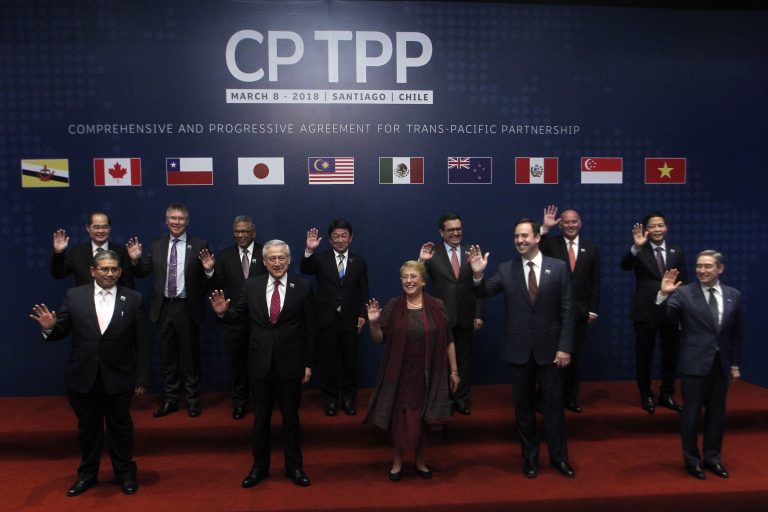According to the official website of China’s Ministry of Commerce, on Sept.16, People’s Republic of China (PRC) Commerce Minister, Wang Wentao, submitted a formal application to join the Comprehensive and Progressive Agreement for Trans-Pacific Partnership (CPTPP) to New Zealand’s Minister of Trade and Export Growth Damien O’Connor, the official depository for the CPTPP parties.
This took place less than 24 hours after the U.S., Australia, and the UK announced a new military partnership, AUKUS, which will enable Australia to have nuclear-powered submarines for the first time.
Less than a week later, on Sept. 22, Taiwan also applied to join the CPTPP, under the designation of “Taiwan, Penghu, Jinma Individual Tariff Area.”
According to Taiwan media reports, Deng Zhenzhong, the chief envoy for economic and trade negotiations of the Taiwan Executive Yuan, said, “Taiwan, Penghu, Jinma, Individual Tariff Area (TPKM) is currently the name of Taiwan’s membership in the World Trade Organization (WTO).” Taiwan has signed economic and trade agreements with other countries in this name.
In recent years, Taiwan — officially known as the Republic of China — has signed free trade agreements with New Zealand and Singapore, using the same designation.
Success
You are now signed up for our newsletter
Success
Check your email to complete sign up
After Taiwan applied to join the CPTPP, Chinese Communist Party-run tabloid Global Times published an article saying “We oppose Taiwan’s participation in any free trade arrangement or signing any free trade agreement with an official nature,” the PRC’s Taiwan Affairs Office spokesperson, Zhu Fenglian, said at a press briefing on Wednesday.
“There is only one China in the world and Taiwan is an inalienable part of China. Taiwan’s participation in regional economic cooperation must be based on the one-China principle,” Zhu said.
Taiwan ranks sixth in the world on the Heritage Foundation’s 2021 Index of Economic Freedom; China is ranked 107th.
According to The Diplomat, “Taiwan is a far more natural fit than China for the CPTPP, which is touted for its high standards on issues like labor protection, environmental issues, and state subsidies.”
Eleven countries signed the CPTPP on March 8, 2018, in Santiago, Chile, including Australia, Brunei, Canada, Chile, Japan, Malaysia, Mexico, Peru, New Zealand, Singapore, and Vietnam. The United States, Australia, Japan, and other countries joined later, following negotiations by the Obama administration.
Former U.S. president Donald Trump signed an executive order in January 2017 to fully withdraw from the TPP out of concern that the agreement would harm the U.S.’s manufacturing industry.
Subsequently, the TPP was renamed the Comprehensive and Progressive Agreement for Trans-Pacific Partnership (CPTPP) on November 11 of the same year under the impetus of Japan and other countries. As per the provisions of the CPTPP, an applicant needs to be approved by all 11 member countries.
According to the Financial Times, The CPTPP’s three largest members are pursuing complaints against China at the World Trade Organization. Japan over steel, Canada over canola and Australia over wine.
Rex Patrick, an independent Australian senator, argued that China would need to “behave properly” before entering the CPTPP and stop “throwing out trade sanctions here, there and everywhere”.
Dan Tehan, Australia’s trade minister, said China’s “track record of compliance” with other trade agreements would affect its CPTPP application. “CPTPP parties want to be confident that an accession candidate would fully implement its commitments in good faith,” Tehan said.
But several Japanese ministers were quick to point to other areas that could pose hurdles for PRC entry, such as the CPTPP’s stringent rules on intellectual property.
“Is China really in a state where it can join?” Taro Aso, Japan’s Finance Minister inquired.
In addition, China has territorial sovereignty disputes in the South China Sea with Vietnam, Brunei and Malaysia, and its relations with these countries are strained.
A former White House National Security Council spokesman said President Biden’s position is clear that the United States will not return to the TPP as it was originally structured.
In February, it took four months for member nations to agree to launch accession negotiations with the UK, which formally applied for CPTPP membership.
Mainland China applied earlier than Taiwan to join the CPTPP, but Beijing may not be accepted before Taiwan, if at all.














